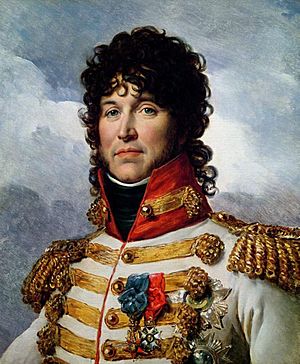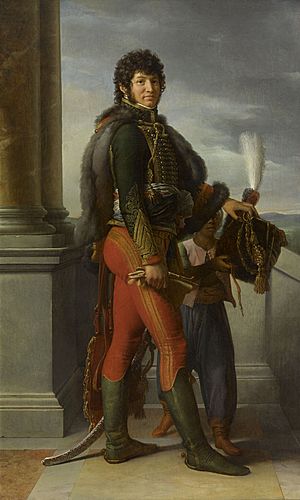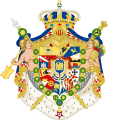Joachim Murat facts for kids
Quick facts for kids Joachim Murat |
|
|---|---|
| Marshal of the Empire | |

Portrait by François Gérard, around 1808
|
|
| King of Naples | |
| Reign | 1 August 1808 – 20 May 1815 |
| Predecessor | Joseph |
| Successor | Ferdinand IV |
| Grand Duke of Berg | |
| Reign | 15 March 1806 – 1 August 1808 |
| Successor | Napoléon Louis |
| Born | Joachim Murat-Jordy 25 March 1767 Labastide-Fortunière, Quercy, Kingdom of France |
| Died | 13 October 1815 (aged 48) Pizzo Calabro, Calabria, Kingdom of Naples |
| Burial | Père Lachaise Cemetery |
| Spouse |
Caroline Bonaparte
(m. 1800) |
| Issue |
|
| House | Murat |
| Father | Pierre Murat-Jordy |
| Mother | Jeanne Loubières |
| Religion | Catholic |
| Signature |  |
|
Marshal of the Empire
Joachim Murat
|
|
|---|---|

Murat in hussar uniform, by François Gérard, 1801
|
|
| Allegiance | |
| Service/ |
Army |
| Years of service | 1787–1813 |
| Rank | Marshal of the Empire |
| Battles/wars |
See list:
|
Joachim Murat (born March 25, 1767 – died October 13, 1815) was a famous French military leader. He was a key figure during the French Revolutionary Wars and the Napoleonic Wars. He became a Marshal of the Empire and even a king under Napoleon Bonaparte.
Murat was born in a small town in France called Labastide-Fortunière. He first thought about becoming a priest. But he soon joined the army instead. He quickly showed he was a brave soldier.
He became very important to Napoleon Bonaparte. Murat helped Napoleon stop a rebellion in Paris in 1795. He then became Napoleon's helper and led the cavalry (soldiers on horseback) in many battles. These included campaigns in Italy and Egypt.
In 1799, Murat helped Napoleon take political power in France. A year later, he married Caroline Bonaparte, Napoleon's sister. This made him Napoleon's brother-in-law.
Napoleon made Murat a Marshal of the Empire. This was a very high military rank. Murat fought in many big battles like Ulm, Austerlitz, Jena, and Eylau. He was known for leading huge cavalry charges.
In 1806, Murat became the Grand Duke of Berg. Then, in 1808, he was made King of Naples. He continued to fight for Napoleon in Russia and Germany. But after a big defeat at the Battle of Leipzig, he left Napoleon. He made a deal with Napoleon's enemies to try and keep his kingdom.
In 1815, Murat tried to fight against the Austrians to keep his power. He was defeated at the Tolentino. He tried to get his throne back, but he was captured. He was put on trial and sentenced to death by a firing squad.
Contents
Early Life and Joining the Army
Joachim Murat was born on March 25, 1767. His hometown was La Bastide-Fortunière in southwestern France. His father, Pierre Murat-Jordy, was a successful farmer and innkeeper. His mother was Jeanne Loubières.
Murat's parents wanted him to become a priest. He studied at a college and then a seminary. But in 1787, he decided to join a cavalry regiment instead. He was a good soldier.
In 1789, he had to leave the army for a short time. He worked as a clerk. But he soon rejoined his regiment. He was a strong supporter of the French Revolution.
Rising Through the Ranks
In 1795, there was a rebellion in Paris. Napoleon Bonaparte was in charge of defending the government. Napoleon asked Murat to get cannons from a nearby area.
Murat successfully brought the cannons to Paris. These cannons helped Napoleon stop the rebellion. This event was very important for both Murat and Napoleon. Napoleon did not forget Murat's help.
Murat then went with Napoleon to fight in Italy in 1796. He was Napoleon's aide and led the cavalry. He also commanded the cavalry during Napoleon's expedition to Egypt in 1798. At the Battle of Abukir in 1799, he led a successful cavalry charge.
Later in 1799, Murat returned to France with Napoleon. He played a key role in Napoleon taking political power. This event is known as the Coup of 18 Brumaire.
In 1800, Murat married Caroline Bonaparte. She was Napoleon's younger sister. This marriage made him part of Napoleon's powerful family.
A Marshal and a King

In 1804, Napoleon made Murat a Marshal of the Empire. This was a very high honor. He was called the "First Horseman of Europe" because of his amazing skills with cavalry. He also became a Prince of the Empire.
Murat fought bravely in many battles between 1805 and 1807. These included the battles of Ulm, Austerlitz, Jena, and Eylau. At Eylau, he led a famous charge with many cavalry soldiers against the Russian army.
In 1806, Murat was given the title of Grand Duke of Berg. He held this title until 1808. Then, he was named King of Naples. He was in charge of the French army in Madrid when a rebellion started there.
Murat was also very important in Napoleon's Russian campaign in 1812. He was known as the best cavalry commander in the Grande Armée. He fought well at battles like Smolensk and Borodino.
However, Murat did not always take good care of his horses. This caused problems during long marches. Horses suffered from hunger and exhaustion.
He continued to serve Napoleon during the German Campaign of 1813. But after Napoleon lost the Battle of Leipzig, Murat made a secret deal with Napoleon's enemies. He switched sides to try and save his own kingdom.
In 1815, Murat declared war on Austria. He wanted to make his rule in Italy stronger. But he was defeated at the Battle of Tolentino in May 1815.
Murat's Final Days
After his defeat, Murat fled to Corsica and then to France. Napoleon refused to see him. After Napoleon's final defeat, Murat tried one last time to get his throne back. He led an expedition to Pizzo in Italy.
But he was soon captured by the forces of King Ferdinand IV of Naples. He was put on trial for trying to take back his throne. He was sentenced to death by a firing squad.
On October 13, 1815, Murat faced his execution bravely. He asked not to be blindfolded. He told the soldiers, "My friends, if you wish to spare me, aim at my heart." He was shot and died that day.
Coats of Arms
Murat's Children
Joachim Murat and Caroline Bonaparte had four children:
- Achille Charles Louis Napoléon Murat (1801–1847). He later moved to Florida in the United States.
- Princess Marie Letizia Josephine Annonciade Murat (1802–1859).
- Lucien Charles Joseph Napoléon Murat (1803–1878). He also spent time in the United States.
- Princess Louise Julie Caroline Murat (1805–1889).
Images for kids
See also
 In Spanish: Joaquín Murat para niños
In Spanish: Joaquín Murat para niños









